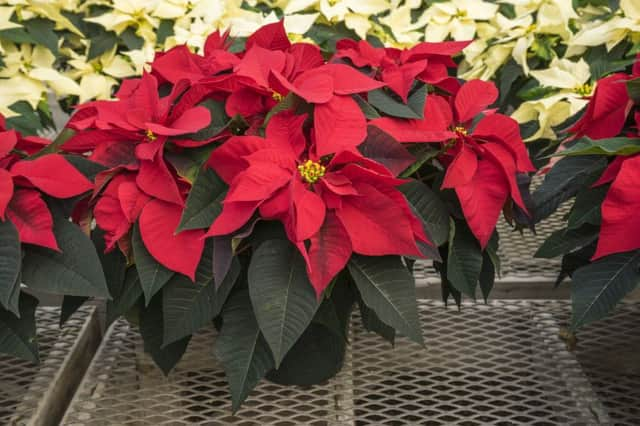Top of the festive pots


This year it’s dropped out of Thompson & Morgan’s top 10 for the first time. At the top of the online plant retailer’s gift predictions is Hyacinth ‘Scented Pearl’, while in second place is the exotic-looking Hibiscus ‘Festive Flair’, which can stand up to the ravages of central heating and cold draughts much better than the coloured bracts of the poinsettia, the firm claims.
“Poinsettias have been given a bad name in recent years thanks to supermarket price wars that have led to cheap imported plants being sold for as little as £1.50,” says Thompson & Morgan spokesman Kris Collins.
Advertisement
Hide AdAdvertisement
Hide Ad“These imports are often grown quickly under artificial lighting, leading to spindly weak plants that are prone to damage from central heating and cold draughts. Once brought into the home, many of these will be dead before Christmas and this experience has put people off them.


“Alongside this, we are seeing a general rise in popularity of houseplants and a younger consumer looking for something a little more contemporary for indoor display over Christmas, hence the rise of the more exotic options such as hibiscus and dendrobium orchid in the Thompson & Morgan Top 10 Christmas list.”
While the Horticultural Trades Association, which represents the UK garden industry, cannot find any evidence backing T&M’s claims, it’s true that poinsettias aren’t the easiest of houseplants. They need to be kept in bright light but not direct sunlight and they hate cold draughts. Room temperatures of 18-24C (64-75F) are ideal. You need to wait until the leaves just show signs of wilting and then give the compost a good soak, but don’t allow the plant to stand in water.
Other options include Christmas cactus, Narcissus tete a tete, scented amaryllis and Christmas azalea, which are all in Thompson & Morgan’s top 10, along with Christmas crocus and Dendrobium orchid ‘Anna Green’.
So, how should you look after them in your house?
Advertisement
Hide AdAdvertisement
Hide Ad:: Christmas cactus: Place it in bright, indirect light and avoid moving the plant as this can cause bud drop. Water moderately and maintain moderate humidity; buds may also drop if conditions are too dry. To boost performance, feed with a good houseplant fertiliser every four weeks when the plant is in growth. Keep the compost only just moist after flowering. The cactus flowers every year. Re-pot every three to four years.
:: Hyacinths (and other bulbs): If not quite in flower, move them close to a window in indirect sunlight. Avoid standing them in a draught or close to a source of artificial heat such as a shelf above a radiator. They prefer a humid atmosphere, so stand pots and vases on shallow trays filled with gravel that is kept moist, but with the water level below the base of the pot. Check regularly if pots need watering or vases topping off. With Christmas bulbs in general, the cooler the room, the longer the flowers will last once they are in bloom. If you place them on the windowsill, turn the bowl regularly so the long flowers remain straight and don’t lean towards the light.
:: Azalea: Provide bright, cool conditions away from full sun. Initially keep the plant well watered using tepid rainwater (if possible). Use a saucer deep enough to hold 2-3cm (1in) of water at all times as azaleas tend to be thirsty. When the plant comes into flower, reduce watering but don’t let the compost dry out completely. Move to a cooler position to prolong the flowering period. Plants may flower for 10 weeks and can be re-potted.
:: Dendrobium orchids: They should be placed in a light spot but not in direct sunlight, ideally a lightly shaded south-facing window. Water your orchids in the morning so that the leaves are dry before night. Dendrobiums like to be in small pots and are usually much taller than the pot is wide. Water once a week (I submerge them in a sink of water just below the pot surface), giving them a good soak and draining them well before putting them back in the pot. They hate wet roots and need to be almost dry before re-watering.
BEST OF THE BUNCH - Holly (Ilex aquifolium)
Advertisement
Hide AdAdvertisement
Hide AdThis prickly evergreen with scarlet red berries is synonymous with Christmas, whether providing colour and form to the winter garden or used to enhance festive wreaths or indoor decorations. Most hollies have male flowers on one plant and females on another and you’ll need to plant at least one of each if you want berries. Don’t be fooled by the names - ‘Silver Queen’ is a male and ‘Martin’ a female, so ask your garden centre to identify the gender. In small gardens, you could plant ‘J C van Tol’, a self-fertile holly with not-too-prickly green leaves that can berry on its own. Hollies like sandy soils and will survive in most soils, but hate waterlogged conditions.
GOOD ENOUGH TO EAT - Sage
This strongly-scented hardy perennial herb is a must if you want a really good stuffing for your turkey at Christmas - and you can grow it earlier in the year and then freeze or dry it for the festive season. It prefers a warm, sunny, sheltered spot, so start seeds off in trays indoors in spring, transferring seedlings to their resting spot after the last frosts. Most sages (there are over 750, the majority ornamental) are native to the Mediterranean regions of southern Europe and Asia Minor. They generally prefer sunny, dry, rocky slopes and look good with low-growing thymes, oregano, marjoram and rosemary. Ideal conditions are full sun, good drainage, a soil pH of 5 to 8 and moderate fertility. Sage needs to be replaced every four or five years, when the plant becomes woody and straggly. The best way to do this is to start new plants from cuttings or by layering.